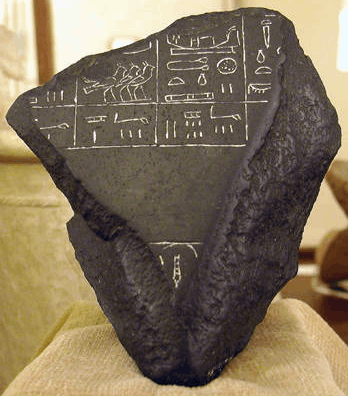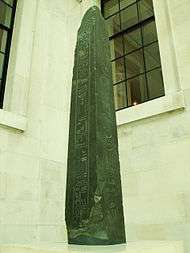Mast (hieroglyph)
| ||
| Ship's Mast in hieroglyphs |
|---|
| ||
| Mast hieroglyph #2 in hieroglyphs |
|---|
The ancient Egyptian ship's mast hieroglyph is one of the oldest language hieroglyphs from Ancient Egypt. It is used on a famous label of Pharaoh Den of the First dynasty, but forms part of the location hieroglyph: Emblem of the East.
|
|
Language usage of ship's mast
The hieroglyphic language equivalent of the mast is 'kh'-('ḥ'), and means "to stand erect", or "to stand vertical"; its use is extensive throughout the language history, and hieroglyphic tomb reliefs and story-telling of Ancient Egypt. It is possibly a forerunner hieroglyph to khā-(now spelled: kh3), the sun rising upon the horizon.
Rosetta Stone usage

In the 198 BC Rosetta Stone, the ship's mast hieroglyph has the unique usage in the final line of the Ptolemy V decree: the mast is used twice-(adjective, verb):
- engrave the decree..: "...upon a vertical-(mast) stone stele"..in the 3-language scripts, .."Shall be made to stand it in the sanctuaries in temples all..."
-

From right, hieroglyphs: sedge of the South, Papyrus clump with leaves of North-Nile Delta, wife-hieroglyph, the tree-hieroglyph, and the Ship's Mast hieroglyph
-

Cartouche amulet, with variant form of mast hieroglyph
-

Old Kingdom of Ancient Egypt: Palermo stone fragment
-

Nectanebo II obelisk, stating that he 'erected' the obelisk, (using the Mast-hieroglyph)
Preceded by
shield-with-arm -- 'ḥa |
mast -- 'h' 'ḥ' |
Succeeded by
brazier-(hieroglyph) '(kh) 'ḥ | ||||||
Succeeded by
brazier -- lizard '(kh) -- '(sh) 'ḥ -- 'š |
See also
| Wikimedia Commons has media related to Mast (hieroglyph). |
- Gardiner's Sign List#P. Ships and Parts of Ships
- Gardiner's Sign List#U. Agriculture, Crafts, and Professions
- Sun rising-Coronation (hieroglyph)
- List of Egyptian hieroglyphs by common name: M-Z
References
- Budge. An Egyptian Hieroglyphic Dictionary, E.A.Wallace Budge, (Dover Publications), c 1978, (c 1920), Dover edition, 1978. (In two volumes) (softcover, ISBN 0-486-23615-3)
- Budge. The Rosetta Stone, E.A.Wallace Budge, (Dover Publications), c 1929, Dover edition(unabridged), 1989. (softcover, ISBN 0-486-26163-8)